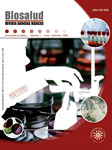Authors
Abstract
The intention of this study is to contribute with information about the behavior of antibiotics to respiratory strains of E. coli, used in poultry production. With a representative sample of five birds by shed, cultures and antibiograms were made for the 5 most commonly used antibiotics in poultry production: Enrofloxacine, Norfloxacine, Ciprofloxacine, Phosphomicine and Trimetoprim-sulphametoxazol. 511 bacterial isolates were made by means of cotton tracheal swap in broiler chickens of 3 to 5 weeks of age with respiratory symptoms. As a result, 88.7% of the isolates corresponded to E. coli stocks, and the remaining 11.3% to other bacteria. When carrying out the antibiograms on E. coli isolates, the findings show that 42.1% were resistant to Ciprofloxacine, followed by Norfloxacine with 46.4%, Enrofloxacine with 62.5%, Phosphomicine with 66.9%, and 78.1% to Trimetoprim-sulphametoxazol. Of all the isolates of E. coli, 78% were considered as being resistant to more than one antibiotic. Additionally, 23.8% of the samples showed resistance to the 5 antibiotics under study, which eliminated any possibility of treatment, while just 2.3% of the cases presented sensitivity to all the antibiotics.
References
Barnes, H. J. et al. [CD-ROM]. Colibacillosis. En: Barnes, H. J. Diseases of Poultry. Capítulo XVIII, EE.UU. Ed. Iowa State Press 2008;p.631-656.
Bazile Pham-Khac Sandrine, et al. Resistance to Fluoroquinolones in Escherichia coli. Isolated from Poultry. Journal of clinical microbiology 1996;40(6):1504-1507.
Blanco, J. E.; Blanco, M; Mora, A; and Blanco, J. Prevalence of bacterial Resistance to Quinolones and Other Antimicrobials among Avian Escherichia coli Strains Isolated from Septicemic and Healthy Chickens in Spain. Journal of clinical microbiology 1998;35(8):2184-2185.
Botero L. Evaluación de la sensibilidad y resistencia de los principales antibacterianos usados en avicultura frente a cepas respiratorias de Escherichia coli. IV Congreso Nacional de Avicultura. Maracaibo 1996;p.45-50.
Cadow. Parsonnet. Kathy. Y Kass Edward, H. Does Prologend Exposure to Antibiotic-Resistant Bateria Increase the Rate of Antibiotic- Resistant Infection? Journal of antimicrobial agents and chemotherapy, 1987;31(6)911-914.
Cotrino, B; Gaviria, B; Espindola, E. [En línea] España, [Cited. 2003]. Los Antibióticos Recursos no renovables. http://www.mundoveterinario.net/
Garau, J; Xercavins M; Rodríguez, M; Gómez, J.R; et al. Emergence and Dissemination of Quinolone-Resistant Escherichia coli in the Community. Journal of antimicrobial agents and chemotherapy 1999;43(11)2736-2741.
Ginns, C.A.; Benham, M.L.; Adams, L.M.; Whithear, K.G.; Bettelheim, K.A.; Crabb, B.S.; and Browning, G.F. Colonization of the Respiratory Tract by a Virulent strain of Avian Escherichia coli Requires Carriage of a Conjugative Plasmid. En: Journal infection and immunity 1999;68(3):1535-1541.
Goren E. Colibacilosis: etiología, patogenia, prevención y terapia. Avicultura profesional 1991;9(2)72-74.
Hanchun, Y; Sheng, C; David, G; Shaohua, Z; Patrick, M; Robert, W; and Jianghong, M; (2004) Characterization of Multiple-Antimicrobial-Resistant Escherichia coli isolates from Diseased Chickens and Swine in China. Journal of clinical microbiology 2004;42(8):3483-3489.
Kojima, Akemi; et al. Extended-Spectrum-ßLactamase-Producing. Eschirichia coli Strains Isolated from Farm Animals from 1999 to 2002: Report from the Japanese Veterinary Antimicrobial Resistance Monitoring Program. En: Antimicrobial Agent and Chemotherapy. Vol. 49 No. 6. May. 2005; p. 3533-3537.
Lee, Y.J; Cho, J.K; Kim, K.S; Tak R.B; Kim, A.R; Kim, J.W; Im, S.K and Kim B.H. Fluoroquinolone resistance and gyrA and gyrC mutations of Escherichia coli isolated from chicken. Journal of microbiology. The Journal of Microbiology 2005;43(5):391-397.
Nagaraja, K. V. Patogenicidad de la E. coli y los factores de stress en los pollos de engorde. Avicultura profesional 1993;10(4):71-74.
National Committee for Clinical Laboratory Standards. Methods for dilution antimicrobial susceptibility tests for bacteria that grow aerobically, 4th ed. Approved standard. Document M7- A4. Villanova 1999;p.1-26.
Ocampo, Mosqueda, Luis Ángel; Gómez, José. Resistencia bacteriana, pruebas de sensibilidad antimicrobiana y algunas consideraciones de salud pública con respecto a la utilización de los antimicrobianos en aves. En: Ocampo, Mosqueda, Luis Ángel; Gómez, José (eds). Terapéutica Avícola. Capítulo IV, México Ed. UNAM 1991;p.37-45.
Ocampo, Camberos, Luis. Uso racional de los antimicrobianos en Medicina Veterinaria. Universidad Autónoma de México, Facultad de Medicina Veterinaria y Zootecnia. Departamento de fisiología y farmacología. México 2003;p.45-54.
Sumano, Héctor; Gutiérrez Lilia. [CD-ROM] Consideraciones farmacológicas de la antibioticoterapia en aves. Memorias seminario AMEVEA Santa Marta 2002;p.490.

 PDF (Español)
PDF (Español)
 FLIP
FLIP














